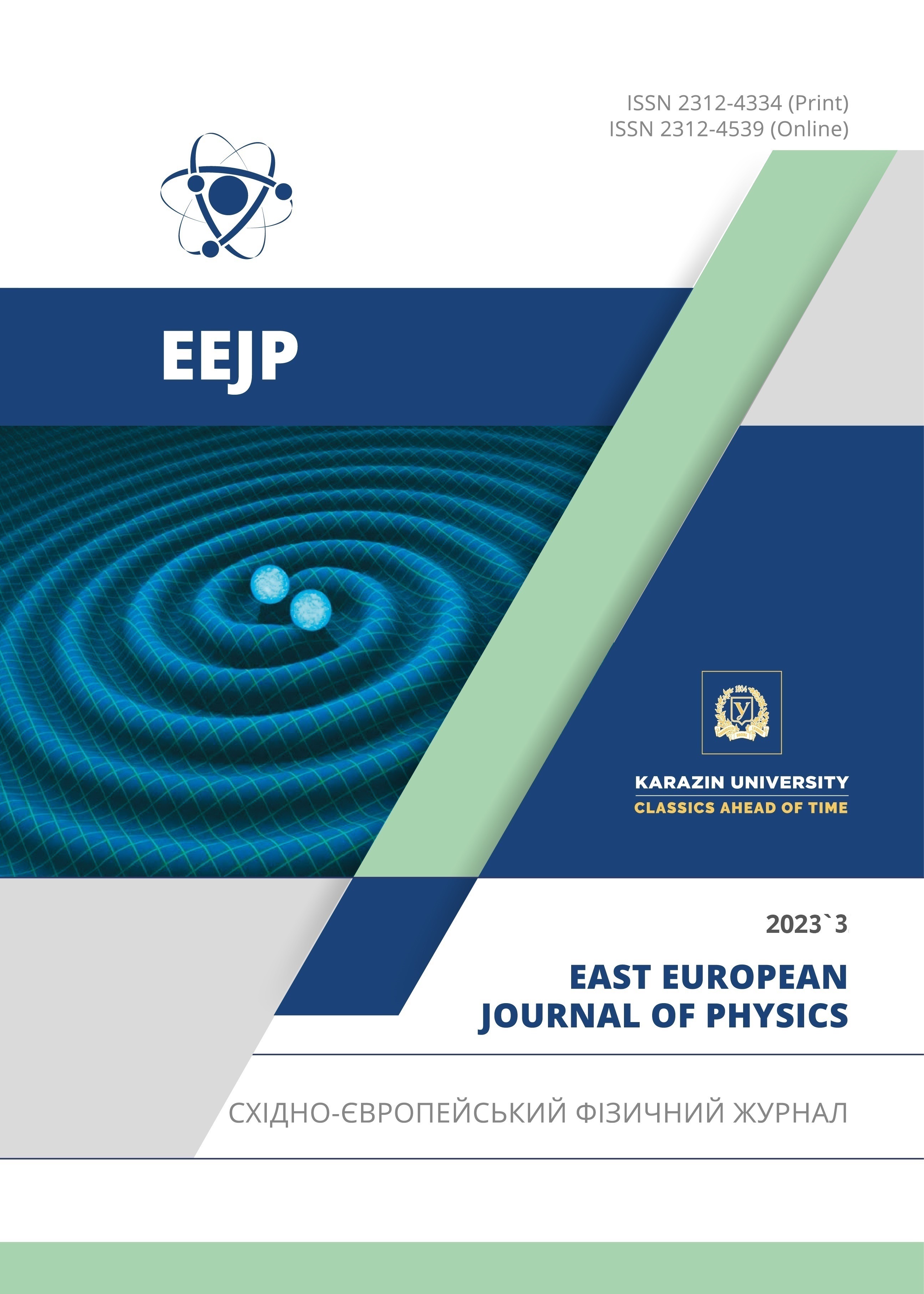Model of Radiation-Induced Motion of Liquid Inclusions in Crystal
Abstract
A physical model is formulated for the motion of liquid inclusions in a crystal in the field of forces caused by the presence of radiation point defects. The model is based on a statistical approach to the processes of induced transitions of structural elements of a crystalline matrix at the interfacial boundary with its solution. From the energy principle, an analytical dependence of the velocity of a spherical azimuthally symmetric inclusion on its size is obtained, considering the threshold nature of the motion. It is shown that the theoretical dependence correlates well with experimental results obtained for inclusions of aqueous saturated solution in potassium chloride crystals irradiated by high-energy electrons. The proposed model of the radiation-induced motion of a liquid inclusion is dynamic and allows us to interpret the nature of inclusion velocity changes in the crystal over time to determine the characteristic energy parameters of point defects.
Downloads
References
N.A. Azarenkov, V.N. Vojevodin, V.G. Kirichenko, G.P. Kovtun, The Journal of Kharkiv National University, Physical series "Nucleus, Particles, Fields". 1(45) 887, 4 (2010), http://nuclear.univer.kharkov.ua/lib/887_1(45)_10_p04-24.pdf
L.I. Barabash, I.N. Vishnevsky, A.A. Groza, A.Ya. Karpenko, P.G. Litovchenko, M.I. Starchik, Problems of Atomic Science and Technology. 2, 182 (2007), https://vant.kipt.kharkov.ua/TABFRAME2.html
A. Karmakar, J. Wang, J. Prinzie, V. Smedt, P. Leroux, Radiation. 1(3), 194 (2021), https://doi.org/10.3390/radiation1030018
V. Gnatyuk, O. Maslyanchuk, O. Kulyk, S. Shishiyanu, T. Aoki, Proceedings of SPIE, 12241, 122410M-1-8 (2022), https://doi.org/10.1117/12.2633410
V. Gnatyuk, S. Levytskyi, O. Maslyanchuk, O. Kulyk, T. Aoki, Proceedings of SPIE, 12126, 1212614-1-8 (2021), https://doi.org/10.1117/12.2615569
A. Lushchik, Ch. Lushchik, E. Vasil’chenko, A.I. Popov, Low Temperature Physics/Fizika Nizkikh Temperatur, 44(4), 357 (2018), https://doi.org/10.1063/1.5030448
N. Itoh, A.M. Stoneham, Materials Modification by Electronic Excitation, (Cambridge University Press, 2000), 520 p.
О.P. Kulyk, O.V Podshyvalova, Bulletin of Kharkiv National Automobile and Highway University, 36, 91 (2007). (In Russian).
A.P. Kulik, O.V. Podshyvalova, and I.G. Marchenko, Problems of Atomic Science and Technology, 2(120), 13 (2019), https://vant.kipt.kharkov.ua/ARTICLE/VANT_2019_2/article_2019_2_13.pdf
О.P. Kulyk, V.I Tkachenko, O.V. Podshyvalova, V.A. Gnatyuk, and T. Aoki, J. Cryst. Growth, 530, 125296-1-7 (2020), https://doi.org/10.1016/j.jcrysgro.2019.125296
O.L. Andrieieva, V.I. Tkachenko, O.P. Kulyk, O.V. Podshyvalova, V.A. Gnatyuk, T. Aoki, East European Journal of Physics, 4, 59 (2021), DOI: 10.26565/2312-4334-2021-4-06
O.P. Kulyk, O.V. Podshyvalova, O.L. Andrieieva, V.I. Tkachenko, V.A. Gnatyuk, T. Aoki, Problems of Atomic Science and Technology, 1(137), 154 (2022), https://doi.org/10.46813/2022-137-154
O.P. Kulyk, L.A. Bulavin, S.F. Skoromnaya, and V.I. Tkachenko, in: Engineering for Sustainable Future. Inter-Academia 2019. Lecture Notes in Networks and Systems(LNNS), vol. 101, edited by A.R. Varkonyi-Koczy (Springer, Cham, 2020) pp. 326-339, https://doi.org/10.1007/978-3-030-36841-8_32
О.P. Kulyk, V.I. Tkachenko, O.L. Andrieieva, O.V Podshyvalova, V.A. Gnatyuk, T. Aoki, in: Research and Education: Traditions and Innovations. INTER-ACADEMIA 2021. Lecture Notes in Networks and Systems, vol. 422 (Springer, Singapure, 2022) pp. 141-158, https://doi.org/10.1007/978-981-19-0379-3_14
Ya.E. Geguzin, and N.N. Ovcharenko, Sov. Phys. Uspekhi, 5(1), 129 (1962), https://dx.doi.org/10.1070/PU1962v005n01ABEH003403
W.W. Mullins, Journal of Applied Physics, 30(1), 77 (1959), https://doi.org/10.1063/1.1734979
Ya.E. Geguzin, Yu.S. Kaganovskij. Diffusion Processes on a Crystal Surface, (Ehnergoatomizdat, Moscow,1984), 128 p. (In Russian).
V.M. Kuklin, The Journal of Kharkov National University, Physical series: Nuclei, Particles, Fields, 933(4/48), 4 (2010). (In Russian).
A. Einstein, Physikalische Gesellschaft Zürich, Mitteilungen 18, 47 (1916).
H.B. Dwight, Tables of Integrals and Other Mathematical Data, 4th edition, (The Macmillan Company, 1961).
A. Betz, Die Naturwissenschaften, XV(46) 905 (1927).
V.S. Kruzhanov, O.V. Podshyvalova, Sov. Solid State Physics, 32(2) 373 (1990). (In Russian).
Copyright (c) 2023 Oleksandr P. Kulyk, Oksana V. Podshyvalova, Mykhailo Yu. Shevchenko, Victor I. Tkachenko, Iryna V. Hariachevska, Toru Aoki

This work is licensed under a Creative Commons Attribution 4.0 International License.
Authors who publish with this journal agree to the following terms:
- Authors retain copyright and grant the journal right of first publication with the work simultaneously licensed under a Creative Commons Attribution License that allows others to share the work with an acknowledgment of the work's authorship and initial publication in this journal.
- Authors are able to enter into separate, additional contractual arrangements for the non-exclusive distribution of the journal's published version of the work (e.g., post it to an institutional repository or publish it in a book), with an acknowledgment of its initial publication in this journal.
- Authors are permitted and encouraged to post their work online (e.g., in institutional repositories or on their website) prior to and during the submission process, as it can lead to productive exchanges, as well as earlier and greater citation of published work (See The Effect of Open Access).








